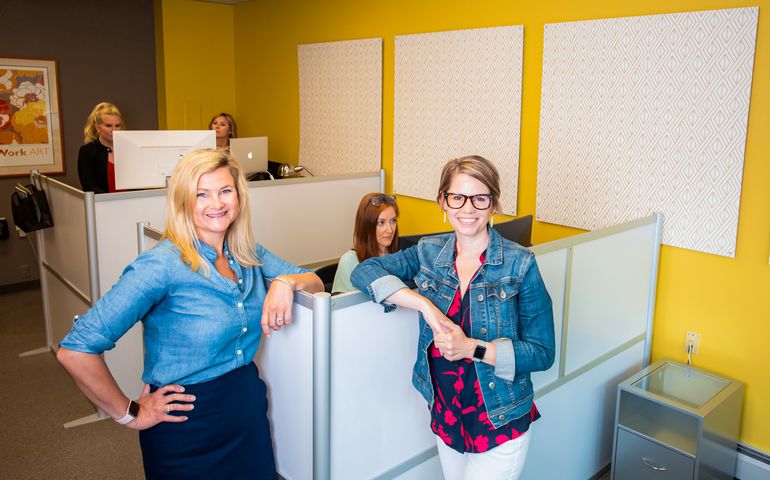
Dressed for a new sort of success: Casual Fridays no longer a thing, other perks come and gone
 File Photo / Tim Greenway
For businesspeople in the 2020s, every day is casual day. This July 2021 file photo shows Warp+Weft co-owners Jennie Malloy, left, and Aimee Goodwin at the branding agency’s reconfigured Auburn office.
File Photo / Tim Greenway
For businesspeople in the 2020s, every day is casual day. This July 2021 file photo shows Warp+Weft co-owners Jennie Malloy, left, and Aimee Goodwin at the branding agency’s reconfigured Auburn office.
In the age of working from home, Zoom shirts and “sweatpants for business,” it’s hard to imagine — 30 years ago, blue jeans were a perk at some blue-chip companies.
Across Maine and the U.S., weekend wear was coming out of the closet a day early. In 1994, the New York Times reported, 497 of the country’s largest 1,000 companies observed casual Fridays.
The trendiest term that year, according to the American Dialect Society, was “casual day.” On Feb. 3, 1995, even gray-suited IBM went casual. That is to say, the company OK’d khakis.
The new look was intended to be a magnet. In the midst of a surging economy, employers were desperately seeking any leverage to attract and retain workers. (Sound familiar?)
Along with the relaxed garb, there were foosball tables in the office, restaurant-grade kitchens with beer on tap, and open-door policies for employee pets.
Those perks took on greater importance — and served as a distraction — as other benefits started to change.
Pensions were becoming more costly for companies and going extinct. American Express announced in 1994 that it would end its fixed-payout retirement plan. Other companies were ending similar benefits and instead offering partially funded 401(k) plans.

The high price of health care was forcing many employers to cut back insurance coverage. While 12% of U.S. companies paid the entire cost of family medical coverage in 1992, Money magazine said, the portion plummeted to just 6% in 1994.
That April, after decades of providing free health care for its U.S. employees and their families, IBM began charging monthly premiums.
‘A more meaningful way’
Today, employees aren’t looking for foosball tables, and are more interested in an employer’s flex hours than in company happy hours.
Just ask Johnna Major, a consultant with Falmouth-based KMA Human Resources Consulting. She entered the HR field in 1995 at shoe manufacturer Cole Haan, then based at “big, beautiful offices” in Yarmouth.

“Dress codes and office configurations have changed dramatically since then,” she says. “And I remember building into our policies that on casual Fridays, you could wear jeans. But then there was this interesting progression of conversation about dress codes and people began questioning a lot of things.”
Soon Major went on to work in a more senior role, as the HR director for a dot-com startup.
“There was all of this money coming in, we had amazing offices and this cool space — and that was something we promoted as part of the culture. It was attractive,” she says. “But today, that’s not why people are going to make a career shift.
“They want a company that respects their work-life balance. They want good health care. They want affordable health care. Some of the ‘fun’ benefits are nice to have, but people really look at workplace culture now in a more meaningful way.”
To find out what workers value most today in the employer relationship, Major’s firm conducted a six-week survey at the start of 2024. The 150 respondents represented a cross-section of ages and seniority levels, from Gen Z to the Baby Boom and from entry-level to executive.
Among the findings of the KMA research were preferences for various untraditional, “creative benefits.” Flexible workweeks and mental health support topped the list, ranking as the most-sought by 67% and 39%, respectively, of those polled.
And the fun stuff? Company outings, onsite recreation and pet insurance were the least-desired creative benefits. None was favorited by more than 12% of the survey respondents.
COVID fast-forward
Casual Fridays and other perks so popular 30 years ago began to lose their magnetic power. Employees learned, the hard way, to value different benefits.
“Those startup companies from the 1990s and early 2000s were a cool place to be. But people saw how quickly those companies could fail,” Major says. “It was fun, but then you hit reality … a generation learned that you can be enslaved to work, and then you get laid off.”
The pandemic accelerated the change to warp speed. Overnight, the flexibility to work from home became a public health necessity. Dress codes became meaningless. Gourmet coffee machines and office beer taps went dry.
Facing grim reminders of their mortality, workers questioned the value of the work they did. Many sought a safer environment in Maine, but no state was immune to the new coronavirus. At the height of the Great Resignation, the employee quit rate in Maine spiked to 3.8%, the ninth-highest in the U.S.

“COVID has played a big part in helping people focus on what’s important to them,” says Major. “It’s helped people understand that having a good health plan, good time off, good leadership — those are foundational to having a good employee experience.
“COVID forced employers to make a shift. But you know, employees have actually wanted that for a long time — since the early 1990s.”
“At the end of the day,” she adds. “It’s really about a solid culture, solid leadership, a respect for employees, a respect for work-life balance. That’s what employees are seeking.”










0 Comments